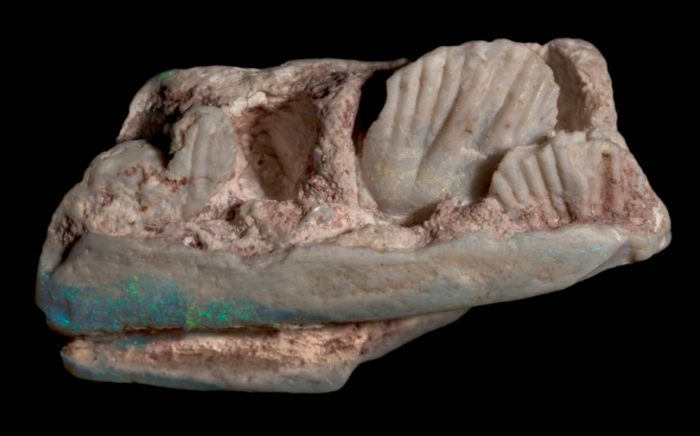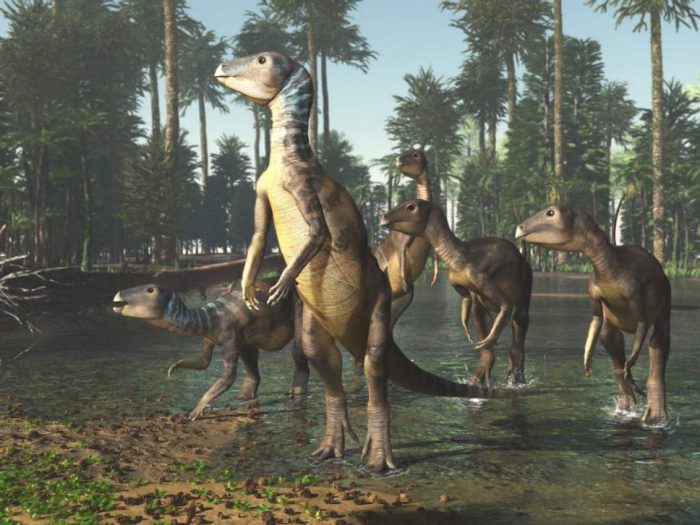The opal is the national gemstone of Australia. Around 95% of the world's precious opal comes from this country.
It is a rare mineraloid that, unlike gems such as diamonds and emeralds, is often clouded or milky in appearance. But despite being so opaque, an opal can have all of the colours of the rainbow. See?
(Getty Embed)
And opals are also responsible for an unusual and beautiful natural occurrence: opal fossils! This is what happened with the recent discovery of the Weewarrasaurus pobeni, a new dog-sized dinosaur that lived during the Cretaceous. In fact, it was an opal dealer who made the discovery!
Hold on a sec ...

The jawbone of the Weewarrasaurus pobeni. It is named for the mine where it was found and the man who discovered it. (Robert A. Smith/University of New England)
The Wee Warra opal field is near Lightning Ridge, New South Wales—a town world-famous for its opals. In 2013, an opal buyer from Adelaide named Michael Poben was sifting through recent finds to see if there was anything worth buying. Something unusual from Wee Warra caught his eye.
Teeth!
This realization led Poben to donate the fossil to the Australian Opal Centre in Lightning Ridge. In 2014, the fossil was first seen by Phil Bell, a paleontologist at the University of New England in Armidale, New South Wales. He spent the next few years studying the fossil and wrote the new report that announced the Weewarrasaurus to the world.
This critter was about the size of a golden retriever, which is adorable. (Who wouldn't want their own dino doggy?) The fossil is about 100 million years old, and is the first new dinosaur named from the state of New South Wales in almost 100 years.
Making rainbows of bones
So what made this fossil so brilliant?
An opalized fossil of an ammonite. (Getty Embed)
As it turns out, opalized fossils are actually not that unusual in Australia (apparently the Australian Opal Centre has quite a collection of them). You may or may not know this, but fossils generally aren't the dinosaur's actual bone. Instead, over millions of years, the bones are slowly replaced by minerals.
This results in new material that is cast in the exact same shape as the original bone or tooth. It's such an excellent copy that scientists can study its structure as though they were looking at the original bone.
Most of the time, the minerals that replace the bones are pretty dull and unremarkable. But if a creature just so happens to die in a part of the world that will go on to produce most of the world's opals? Let's just say that the future of the Weewarrasaurus was looking bright!
 Nice dino doggy! The Weewarrasaurus pobeni is a new species of dinosaur with an especially beautiful fossil. (James Kuether/University of New England)
Nice dino doggy! The Weewarrasaurus pobeni is a new species of dinosaur with an especially beautiful fossil. (James Kuether/University of New England)










Hi to all at OWLconnected 😀
and THANK YOU for such an entertaining article on Australia’s new Dinosaur,
Weewarrasaurus pobeni.
Puns galore! 😆 😆 😆
Owl always be grateful for your interest … 😀 .
Dr. Elizabeth Smith from the Australian Opal Centre in Lightning Ridge NSW researched the meaning of “Wee Warra” from the Indigenous language. It’s a beautiful coincidence that “Wee Warra” translates roughly to “fire standing up”.
A 100 million-year-old plant-eating dinosaur, standing, preserved in the fire of precious opal!
thanks again, Mike Poben, in Adelaide South Oz.
Thanks for the news!
You know I love dinosaurs! 🙂
Please send more news about dinosaurs! 🙂
woah I had no idea that there are fossils made of opal. 😮